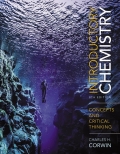
EBK INTRODUCTORY CHEMISTRY
8th Edition
ISBN: 9780134553153
Author: CORWIN
Publisher: PEARSON CO
expand_more
expand_more
format_list_bulleted
Concept explainers
Question
Chapter 20, Problem 49E
Interpretation Introduction
Interpretation:
The number of hydrogen bonds between adenine and thymine nucleotides in the double helical DNA is to be stated.
Concept introduction:
DNA stands for deoxyribonucleic acid, is a biological macromolecule. DNA contains double helical strands along with the complementary base pairs. The four complementary bases of DNA are adenine (A), thymine (T), guanine (G) and cytosine (C).
Expert Solution & Answer
Want to see the full answer?
Check out a sample textbook solution
Students have asked these similar questions
What is the pH of a 1.0 L buffer made with 0.300 mol of HF (Ka = 6.8 × 10⁻⁴) and 0.200 mol of NaF to which 0.160 mol of NaOH were added?
Can I please get help with this.
Determine if the following salt is neutral, acidic or basic. If acidic or basic, write the appropriate equilibrium equation for the acid or base that exists when the salt is dissolved in aqueous solution. If neutral, simply write only NR. Be sure to include the proper phases for all species within the reaction. N₂H₅ClO₄
Chapter 20 Solutions
EBK INTRODUCTORY CHEMISTRY
Ch. 20 - Prob. 1CECh. 20 - Prob. 2CECh. 20 - Prob. 1KTCh. 20 - Prob. 2KTCh. 20 - Prob. 3KTCh. 20 - Prob. 4KTCh. 20 - Prob. 5KTCh. 20 - Prob. 6KTCh. 20 - Prob. 7KTCh. 20 - Prob. 8KT
Ch. 20 - Prob. 9KTCh. 20 - Prob. 10KTCh. 20 - Prob. 11KTCh. 20 - Prob. 12KTCh. 20 - Prob. 13KTCh. 20 - Prob. 14KTCh. 20 - Prob. 15KTCh. 20 - Prob. 16KTCh. 20 - Prob. 17KTCh. 20 - Prob. 18KTCh. 20 - Prob. 19KTCh. 20 - Prob. 20KTCh. 20 - Prob. 21KTCh. 20 - Prob. 22KTCh. 20 - Prob. 23KTCh. 20 - Prob. 24KTCh. 20 - Prob. 25KTCh. 20 - Prob. 26KTCh. 20 - Prob. 27KTCh. 20 - Prob. 28KTCh. 20 - Prob. 1ECh. 20 - Prob. 2ECh. 20 - Prob. 3ECh. 20 - Prob. 4ECh. 20 - Prob. 5ECh. 20 - Prob. 6ECh. 20 - Prob. 7ECh. 20 - Prob. 8ECh. 20 - Prob. 9ECh. 20 - Prob. 10ECh. 20 - Prob. 11ECh. 20 - Prob. 12ECh. 20 - Prob. 13ECh. 20 - Prob. 14ECh. 20 - Prob. 15ECh. 20 - Prob. 16ECh. 20 - Prob. 17ECh. 20 - Prob. 18ECh. 20 - Prob. 19ECh. 20 - Prob. 20ECh. 20 - Prob. 21ECh. 20 - Prob. 22ECh. 20 - Prob. 23ECh. 20 - Prob. 24ECh. 20 - Prob. 25ECh. 20 - Prob. 26ECh. 20 - Prob. 27ECh. 20 - Prob. 28ECh. 20 - Prob. 29ECh. 20 - Prob. 30ECh. 20 - Prob. 31ECh. 20 - Prob. 32ECh. 20 - Prob. 33ECh. 20 - Prob. 34ECh. 20 - Prob. 35ECh. 20 - Prob. 36ECh. 20 - Prob. 37ECh. 20 - Prob. 38ECh. 20 - Prob. 39ECh. 20 - Prob. 40ECh. 20 - Prob. 41ECh. 20 - Prob. 42ECh. 20 - Prob. 43ECh. 20 - Prob. 44ECh. 20 - Prob. 45ECh. 20 - Prob. 46ECh. 20 - Prob. 47ECh. 20 - Prob. 48ECh. 20 - Prob. 49ECh. 20 - Prob. 50ECh. 20 - Prob. 51ECh. 20 - Prob. 52ECh. 20 - Prob. 53ECh. 20 - Prob. 54ECh. 20 - Prob. 55ECh. 20 - Prob. 56ECh. 20 - Prob. 57ECh. 20 - Prob. 58ECh. 20 - Prob. 59ECh. 20 - Prob. 60ECh. 20 - Prob. 61ECh. 20 - Prob. 62ECh. 20 - Prob. 63ECh. 20 - Prob. 64ECh. 20 - Prob. 65ECh. 20 - Prob. 66ECh. 20 - Prob. 1STCh. 20 - Prob. 2STCh. 20 - Prob. 3STCh. 20 - Prob. 4STCh. 20 - Prob. 5STCh. 20 - Prob. 6STCh. 20 - Prob. 7STCh. 20 - Prob. 8STCh. 20 - Prob. 9STCh. 20 - Prob. 10STCh. 20 - Prob. 11STCh. 20 - Prob. 12STCh. 20 - Prob. 13STCh. 20 - Prob. 14STCh. 20 - Prob. 15STCh. 20 - Prob. 16STCh. 20 - Prob. 17STCh. 20 - Prob. 18STCh. 20 - Prob. 19ST
Knowledge Booster
Learn more about
Need a deep-dive on the concept behind this application? Look no further. Learn more about this topic, chemistry and related others by exploring similar questions and additional content below.Similar questions
arrow_back_ios
SEE MORE QUESTIONS
arrow_forward_ios
Recommended textbooks for you
- Chemistry: Matter and ChangeChemistryISBN:9780078746376Author:Dinah Zike, Laurel Dingrando, Nicholas Hainen, Cheryl WistromPublisher:Glencoe/McGraw-Hill School Pub Co
 Introductory Chemistry: An Active Learning Approa...ChemistryISBN:9781305079250Author:Mark S. Cracolice, Ed PetersPublisher:Cengage Learning
Introductory Chemistry: An Active Learning Approa...ChemistryISBN:9781305079250Author:Mark S. Cracolice, Ed PetersPublisher:Cengage Learning Chemistry for Today: General, Organic, and Bioche...ChemistryISBN:9781305960060Author:Spencer L. Seager, Michael R. Slabaugh, Maren S. HansenPublisher:Cengage Learning
Chemistry for Today: General, Organic, and Bioche...ChemistryISBN:9781305960060Author:Spencer L. Seager, Michael R. Slabaugh, Maren S. HansenPublisher:Cengage Learning  World of ChemistryChemistryISBN:9780618562763Author:Steven S. ZumdahlPublisher:Houghton Mifflin College Div
World of ChemistryChemistryISBN:9780618562763Author:Steven S. ZumdahlPublisher:Houghton Mifflin College Div World of Chemistry, 3rd editionChemistryISBN:9781133109655Author:Steven S. Zumdahl, Susan L. Zumdahl, Donald J. DeCostePublisher:Brooks / Cole / Cengage Learning
World of Chemistry, 3rd editionChemistryISBN:9781133109655Author:Steven S. Zumdahl, Susan L. Zumdahl, Donald J. DeCostePublisher:Brooks / Cole / Cengage Learning Chemistry: Principles and PracticeChemistryISBN:9780534420123Author:Daniel L. Reger, Scott R. Goode, David W. Ball, Edward MercerPublisher:Cengage Learning
Chemistry: Principles and PracticeChemistryISBN:9780534420123Author:Daniel L. Reger, Scott R. Goode, David W. Ball, Edward MercerPublisher:Cengage Learning

Chemistry: Matter and Change
Chemistry
ISBN:9780078746376
Author:Dinah Zike, Laurel Dingrando, Nicholas Hainen, Cheryl Wistrom
Publisher:Glencoe/McGraw-Hill School Pub Co

Introductory Chemistry: An Active Learning Approa...
Chemistry
ISBN:9781305079250
Author:Mark S. Cracolice, Ed Peters
Publisher:Cengage Learning

Chemistry for Today: General, Organic, and Bioche...
Chemistry
ISBN:9781305960060
Author:Spencer L. Seager, Michael R. Slabaugh, Maren S. Hansen
Publisher:Cengage Learning

World of Chemistry
Chemistry
ISBN:9780618562763
Author:Steven S. Zumdahl
Publisher:Houghton Mifflin College Div

World of Chemistry, 3rd edition
Chemistry
ISBN:9781133109655
Author:Steven S. Zumdahl, Susan L. Zumdahl, Donald J. DeCoste
Publisher:Brooks / Cole / Cengage Learning

Chemistry: Principles and Practice
Chemistry
ISBN:9780534420123
Author:Daniel L. Reger, Scott R. Goode, David W. Ball, Edward Mercer
Publisher:Cengage Learning
Nucleic acids - DNA and RNA structure; Author: MEDSimplified;https://www.youtube.com/watch?v=0lZRAShqft0;License: Standard YouTube License, CC-BY